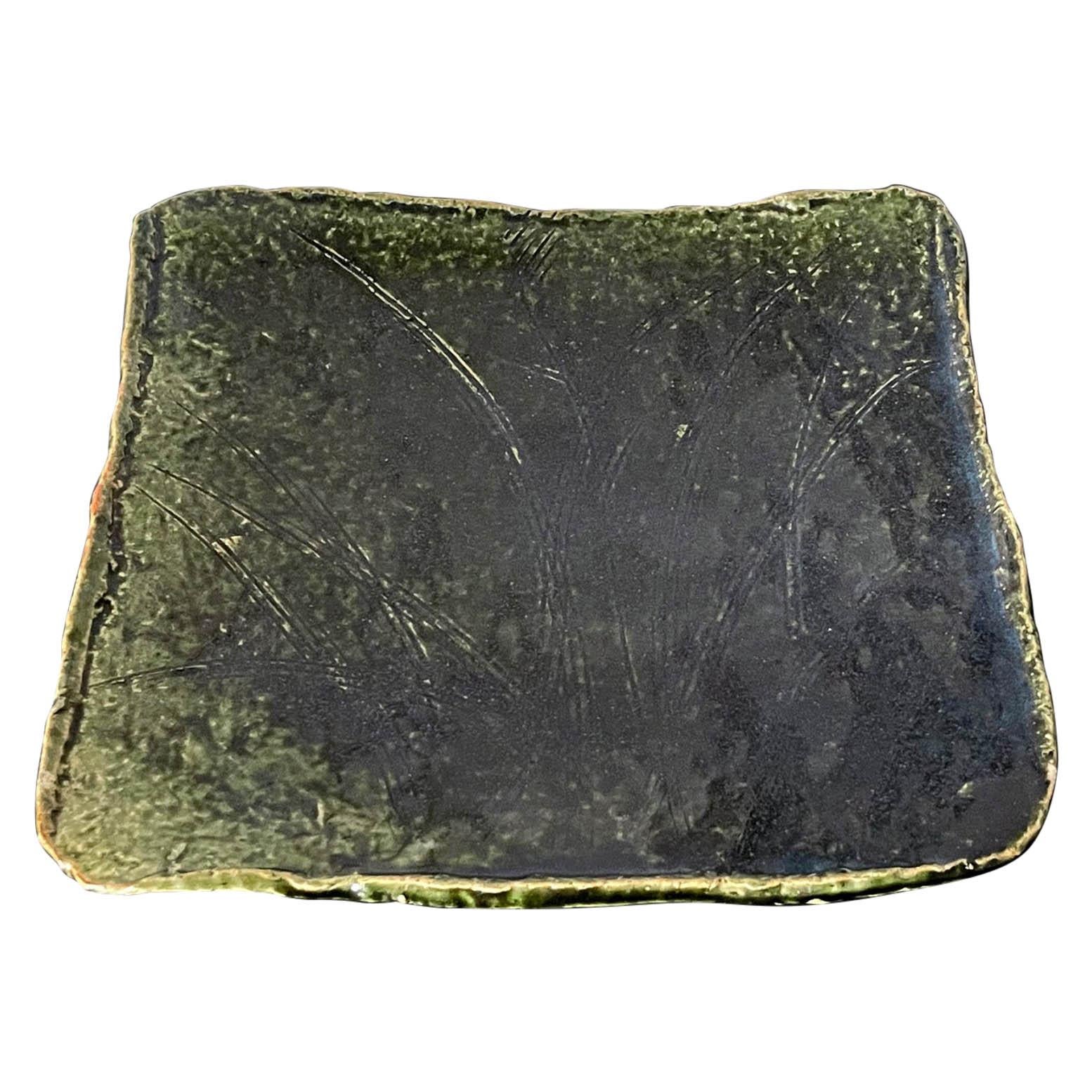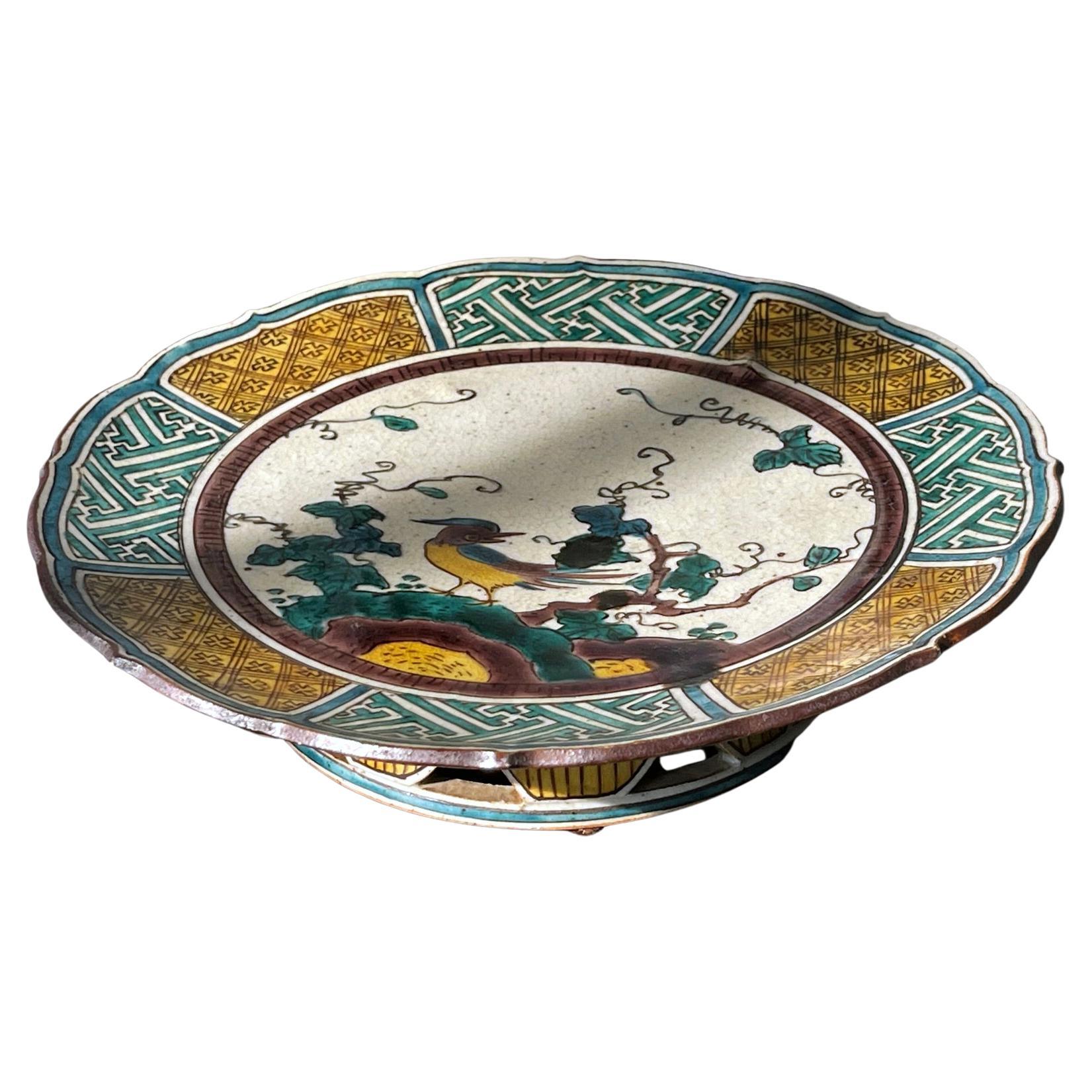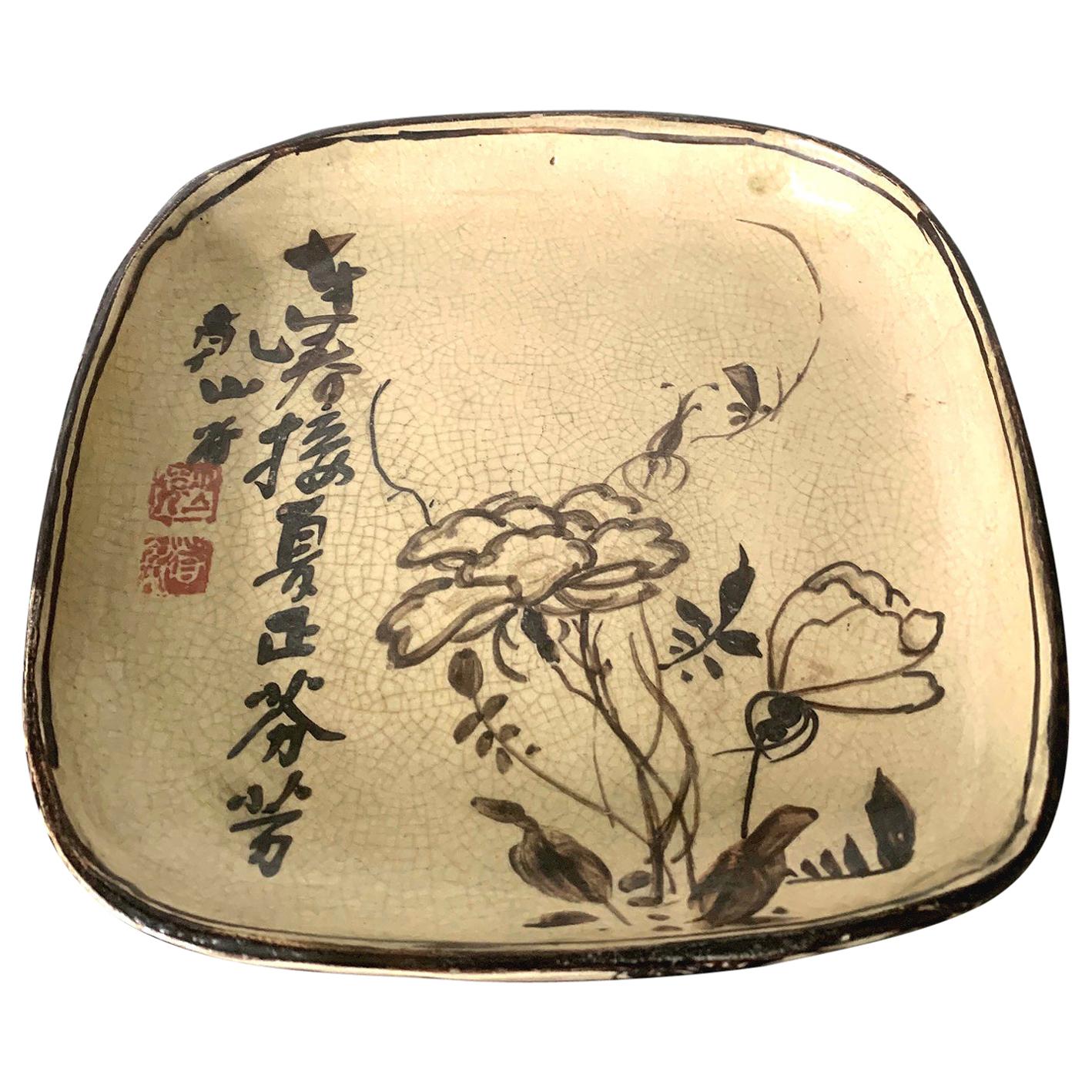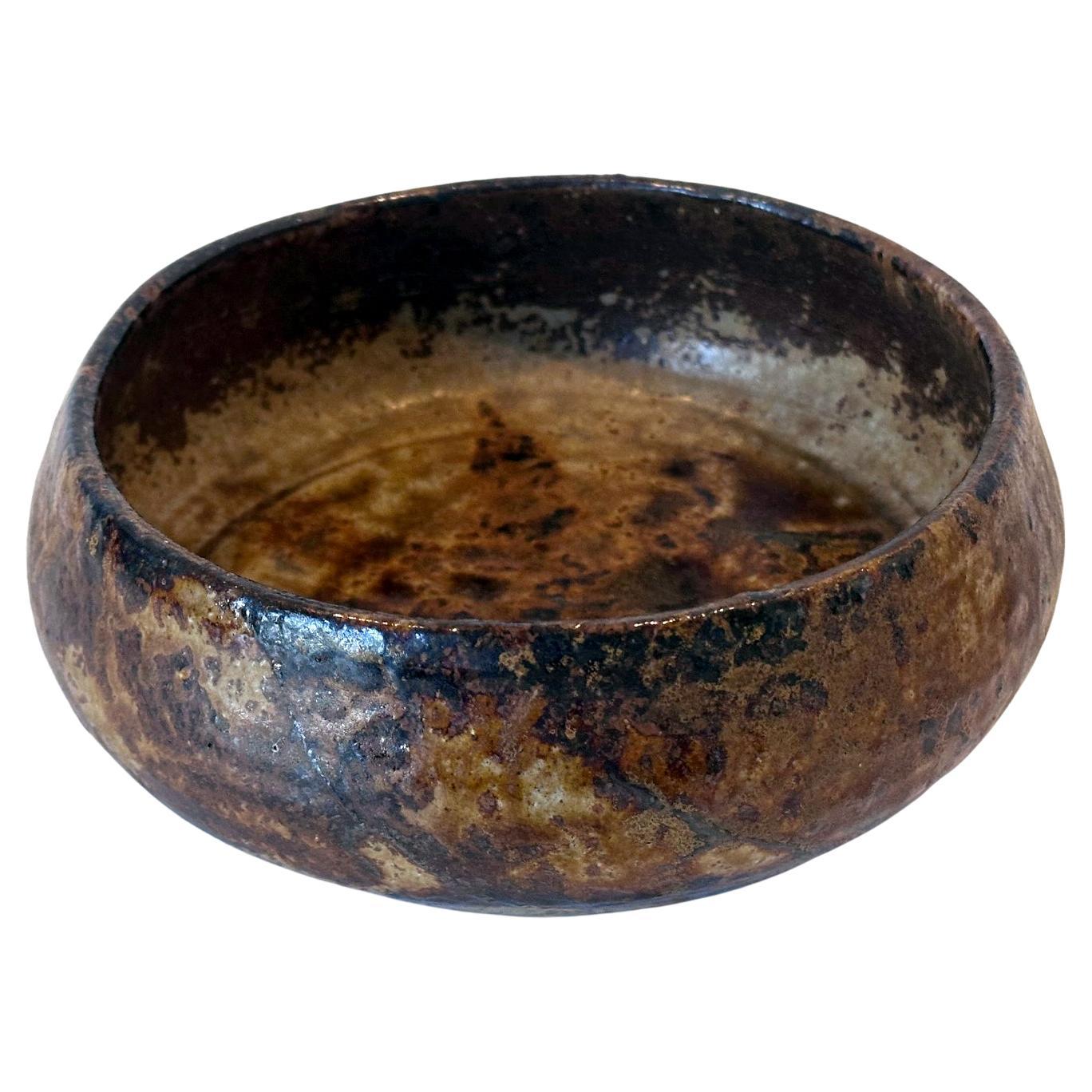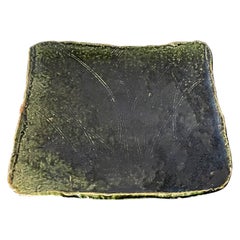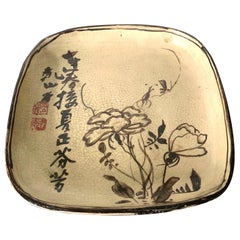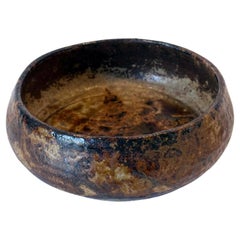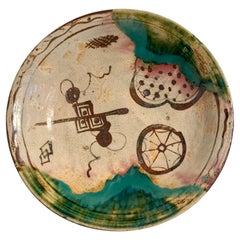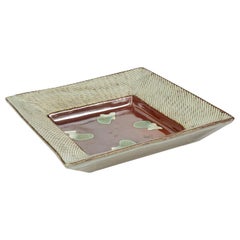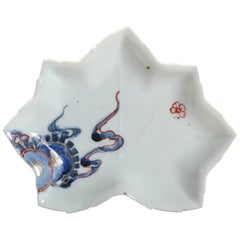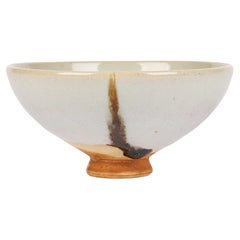Items Similar to Japanese Oribe Glazed Stoneware Dish by Kitaoji Rosanjin
Want more images or videos?
Request additional images or videos from the seller
1 of 17
Japanese Oribe Glazed Stoneware Dish by Kitaoji Rosanjin
$12,000
£9,174.64
€10,567.33
CA$16,815.68
A$18,773.12
CHF 9,836.84
MX$229,801.47
NOK 124,927.90
SEK 117,791.15
DKK 78,865.07
About the Item
An oribe stoneware square dish with four notched corners and up-turned edges made by Kitaoji Rosanjin (1883-1959) circa 1950s. The Mingei style dish has a wonderful casual form with green glaze outlining the sharply shaped edges. The interior surface is covered with an iron-red persimmon glaze in a grid pattern drawn with free-hand. The base of the dish is incised with the artist's insignia. The original storage box tomobako bears the title Eight Inch Dish, Oribe, the artist's name Rosanjin as shown. The piece exuberates the folk art (Mingei) spirit in its slightly irregular hand-cut form and decoration that is rooted in Oribe tradition but with the addition of the persimmon glaze which was favored by Mingei potter such as Rosanjin himself and Hamada Shoji.
PROVENANCE: Joan B. Mirviss, New York, March 2013. With an original copy of invoice.
Kitaoji Rosanjin (1883-1959) was the pseudonym for a noted artist and epicure during the early to mid-Showa period of Japan. His real name was Kitaoji Fusajiro. An artistic man with many talents, he has an extraordinary influence on Japanese art scene. For his complete biography, refer to source such as e-yakinomo and Rosanjin Net. According to the 2018 exhibition catalog of Kuroda Ceramics Co., Ltd on Kitaoji Rosanjin, in 1921, Rosanjin founded a restaurant for members only called “Bishoku Club (Gourmet's Club)” on the second floor of his gallery, where he began serving Kyoto-style food on his collection of ceramics, such as old Sometsuke, Aka-e, the Oranda, Old Seto, Karatsu, and Oribe. He started making his own ceramic after his collection was destroyed in the earthquake in 1923.
- Creator:Rosanjin Kitaoji (Artist)
- Dimensions:Height: 1.45 in (3.69 cm)Width: 8.5 in (21.59 cm)Depth: 8.5 in (21.59 cm)
- Style:Modern (Of the Period)
- Materials and Techniques:Ceramic,Glazed
- Place of Origin:
- Period:
- Date of Manufacture:1950s
- Condition:Wear consistent with age and use. Fine condition. Tomobako shows minor normal wear.
- Seller Location:Atlanta, GA
- Reference Number:1stDibs: LU945030791552
About the Seller
4.9
Platinum Seller
Premium sellers with a 4.7+ rating and 24-hour response times
Established in 2006
1stDibs seller since 2010
565 sales on 1stDibs
Typical response time: <1 hour
- ShippingRetrieving quote...Shipping from: Atlanta, GA
- Return Policy
Authenticity Guarantee
In the unlikely event there’s an issue with an item’s authenticity, contact us within 1 year for a full refund. DetailsMoney-Back Guarantee
If your item is not as described, is damaged in transit, or does not arrive, contact us within 7 days for a full refund. Details24-Hour Cancellation
You have a 24-hour grace period in which to reconsider your purchase, with no questions asked.Vetted Professional Sellers
Our world-class sellers must adhere to strict standards for service and quality, maintaining the integrity of our listings.Price-Match Guarantee
If you find that a seller listed the same item for a lower price elsewhere, we’ll match it.Trusted Global Delivery
Our best-in-class carrier network provides specialized shipping options worldwide, including custom delivery.More From This Seller
View AllJapanese Oribe Square Dish by Kitaoji Rosanjin
By Rosanjin Kitaoji
Located in Atlanta, GA
An Oribe-Style rectangular dish with a slightly concaved slab body and up-turned irregular edges, made by Kitaoji Rosanjin (1883-1959) circa 1930-50s....
Category
20th Century Japanese Modern Ceramics
Materials
Ceramic
Antique Japanese Ceramic Ko-Kutani Revival Footed Dish
Located in Atlanta, GA
A Japanese glazed ceramic footed dish made in the Ko-Kutani type of Edo period but likely during Kutani revival in the 19th century Meiji Period. The dish with delicate foliaged rim ...
Category
Antique 19th Century Japanese Japonisme Ceramics
Materials
Ceramic
Japanese Ceramic Dish Meiji Ogata Kenzan
Located in Atlanta, GA
A Japanese ceramic shallow dish in square form with rounded corners from Meiji period in the style of Ogata Kenzan. The dish features a cream color crackl...
Category
Antique 19th Century Japanese Meiji Ceramics
Materials
Ceramic
Japanese Glazed Stoneware Bowl by Kitaoji Rosanjin Ex-Musuem Collection
By Rosanjin Kitaoji
Located in Atlanta, GA
A stoneware round bowl with dramatic glaze made by Kitaoji Rosanjin (1883-1959) circa first half of the 20th century. The low height bowl with wide opening and swell body resembles a...
Category
Mid-20th Century Japanese Modern Ceramics
Materials
Ceramic
Rare Published Japanese Ceramic Bowl Makuzu Kozan with Original Inscribed Box
By Makuzu Kozan
Located in Atlanta, GA
A rare published glazed ceramic bowl with surface paint decoration by Japanese imperial potter Makuzu Kozan ((1842–1916) with its original inscribed tomobako storage wood box. Unlike the better-known works Kozan made for the expositions in the west and export to the foreign market, this piece exemplifies his work for the domestic market and specifically, the tea ceremony. The bowl was made in the so called "Utusushi" Ogata Kenzan (1663-1743), a celebrated Edo painter and ceramicist. Utusushi is loosely translated as "in the spirit of". It is not at all a simple imitation of a master, but a Japanese concept of embracing the spiritual essence of a master while the creator is free to mix in his or her own unique artistic interpretation and flavor.
The bowl was made to hold sweet cakes during the tea ceremony. It has a very distinguished form with a circular swelled lower body morphing into a square upper portion that further opening with flared rim. The surface has a distinct glaze pattern partitioned diagonally in black and brown. On top, snow-covered branches of prunus flowers were painted overglaze in a poetic near-abstract fashion. Blooming in winter, prunus flower is the symbol of the season and cherished for its resistance to cold. The bowl was likely reserved for the tea ceremony during the winter months.
A white porcelain plaque with Kozan in black inlay was placed on the black glaze toward the bottom. Under the base, the bowl was further branded with two incised characters "Makuzu" as shown. The original tomobako bears ink inscription and paper slip label "Sweet Bowl...
Category
Antique Early 1900s Japanese Meiji Ceramics
Materials
Ceramic
Japanese Ceramic Bowl Makuzu Kozan Utusushi Kenzan
By Makuzu Kozan
Located in Atlanta, GA
A rare ceramic bowl with overglaze paint decoration by Japanese imperial potter Makuzu Kozan ((1842–1916). Unlike the better-known works Kozan made for the expositions in the west and export to the foreign market, this piece exemplifies his work for the domestic market and the tea ceremony. The bowl was made in the so called "Utusushi" Ogata Kenzan (1663-1743), a celebrated Edo painter and ceramicist. Utusushi is loosely translated as "in the spirit of". It is not at all a simple imitation of a master, but a Japanese concept of embracing the spiritual essence of a master while the creator is free to mix in his or her own unique artistic interpretation and flavor.
The bowl was made to hold fruits during the tea ceremony. It has a very distinguished form with a circular lower body morphing into a square upper portion that further opening with flared rim. The surface has a grey glaze onto which Asagao flowers (Japanese morning glory) on the vines were painted in a free and poetic style. White was used for the petals, green for the leaves with touches of gold highlight. Asagao, the symbol of the summer was rendered in the spirit of Ogata Kenzan, and interestingly the shape of the blossom echoes the unique form the bowl. It was likely reserved for the tea ceremony during the summer months.
Under the base, Kozan was signed in black on a white porcelain plaque inlay.
For two similar examples of Kozan's work Utusushi Kenzan, see Page 168-169 of the book: Sekai ni Aisa Reta ya Kimono Miyagawa Kozan Makuzu...
Category
Antique Early 1900s Japanese Japonisme Ceramics
Materials
Ceramic
You May Also Like
Japanese Ao-Oribe Glazed Stoneware Dish, Early Edo Period, 17th Century, Japan
Located in Austin, TX
A fine and rare Japanese ao-oribe glazed minoyaki stoneware dish, late Momoyama or early Edo period, 17th century, Japan.
The circular dish of wheel thrown ...
Category
Antique 17th Century Japanese Edo Ceramics
Materials
Stoneware
Tatsuzo Shimaoka Square Stoneware Studio Pottery Plate, 20th Century
By Tatsuzo Shimaoka 2
Located in Bishop's Stortford, Hertfordshire
A rare and fine vintage Tatsuzo Shimaoka (1919-2007) stoneware studio pottery plate of square form with raised rim and central recess. The plate h...
Category
20th Century Japanese Ceramics
Materials
Stoneware
Antique Ko-Kutani Edo Period Japanese Porcelain Dish Arita, 17th Century
Located in Amsterdam, Noord Holland
A very nice leaf shaped polychrome dish of moulded shape. Unusual shape and painting.
Early Edo period.
Additional information:
Material: Porcelain & Pottery
Japanese Style: Kutani...
Category
Antique 17th Century Japanese Edo Decorative Dishes and Vide-Poche
Materials
Porcelain
$1,255 Sale Price
20% Off
Chinese Jun Ware Streak Glazed Art Pottery Bowl
Located in Bishop's Stortford, Hertfordshire
A very stylish good quality Chinese Jun Ware pottery bowl decorated with streaked glazes on a red and pale blue glazed ground dating from the latter 19th o...
Category
Antique 19th Century Chinese Other Ceramics
Materials
Pottery
Shoji Hamada Japanese Mingei Pottery Plate with Original Signed Sealed Box
By Shoji Hamada
Located in Studio City, CA
An exquisite, unique plate by master Japanese potter Shoji Hamada, a fine early example of his iron pigment brushed and glazed bamboo hakeme motif. The original Hamada stamped or sealed and signed box is included. Rare to find such a beautiful piece in such impeccable condition with its original signed box.
This work is sure to shine in any collection or setting.
Shoji Hamada was designated a Living National Treasure in Japan in 1955. In 1968 he received Japan's highest artistic award the Order of Culture. His work can be found in collections and museums worldwide including Tokyo’s Japan Folk Art Museum and The Tate Museum...
Category
Early 20th Century Japanese Showa Ceramics
Materials
Stoneware
Vintage Japanese Bizen ware Takatori Family W/ Original Box
Located in Atlanta, GA
Takatori Family (Japanese, 20th century).
A bizen ware or Bizen yaki pottery vessel produced in the Okayama region of Japan. Housed inside the original wood box.
Vessel measures: ...
Category
20th Century Japanese Ceramics
Materials
Ceramic
$280 Sale Price
20% Off
More Ways To Browse
Japanese Stoneware
Vintage Persimmon
Covered Serving Dish
Japanese Shoji
Hamada Shoji
Japanese Iron Box
Japanese Ceramics Mingei
Showa Stoneware
Japanese Oribe
Seto Ceramic
Oribe Ceramics
Kitaoji Rosanjin
Oribe Dish
Antique Japanese Charger
Chinese Yongzheng
Chinese Mandarin
Porcelain Yongzheng
Chinese Export Porcelain Marks
